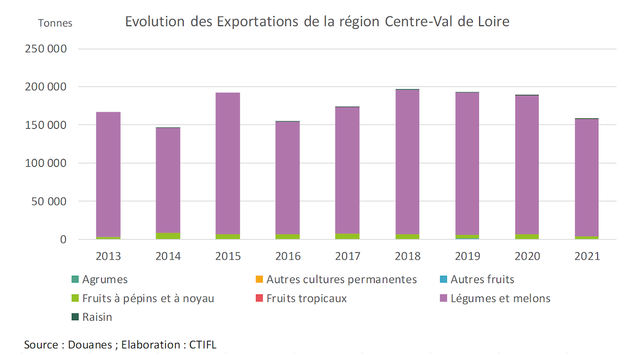The Centre-Val de Loire region is a reference for fresh fruit and vegetable production, with more than 580,000 tons produced each year.
For the past 2 years, the 8,500 professionals of the fresh fruit and vegetable sector in this region (producers, shippers, wholesale and retail distributors and catering professionals) have formed the Interfel regional committee of Centre-Val de Loire. This enables the sector to respond to consumer needs as closely as possible.
 Benoît Gilles, president of INTERFEL Centre-Val de Loire - copyright: Interfel Centre-Val de Loire
Benoît Gilles, president of INTERFEL Centre-Val de Loire - copyright: Interfel Centre-Val de Loire
Very dynamic fruit and vegetable production in the Centre-Val de Loire region
The Centre-Val de Loire region counts almost 20,000 farms, 1,810 of which grow vegetables and 685 produce fruit.
The fruit production of this French region (apples (5% of national production), pears (9% of national production), cherries (1,200 tons), strawberries (3,000 tons) and nuts) represents approximately 4% of the national volume. The vegetable production of the region is more significant, accounting for 8% of the national volume, thanks in particular to the production of onions, red beet, mushrooms and parsley.
“The Centre-Val de Loire region is France's leading onion-growing basin (53% of national production). The region is also home to France's largest beet production (38% of national production), most of which is then processed for cooked consumption. Besides these crops, the Centre-Val de Loire is also characterized by a real diversity of fresh produce (lettuce, radishes, cucumbers...),” explains Benoît Gilles, president of INTERFEL Centre-Val de Loire.
The regional consumption still needs to grow
Despite this high level of regional production, the inhabitants of the Centre-Val de Loire region are not big consumers of fresh fruit and vegetables. They buy 11 kg less fresh fruit and vegetables per household per year on average than the national average (168 kg/year) (sources: Kantar data - CTIF calculations). “This gap can be partly explained by the large number of private gardens in the region.”
“In order to boost fruit and vegetable consumption in the region, the Interfel committee of Centre-Val de Loire has been working with the regional and departmental councils to run awareness campaigns in high schools and middle schools. Interfel's network of dieticians, in conjunction with Aprifel (agency for research and information on fruit and vegetables), is also setting up communication and edutainment initiatives aimed at school children. It is important to increase fruit and vegetable consumption among children and teenagers, who can also influence their parents into buying more fruit and vegetables for their family.”
A number of actions aimed at the general public will take place until the end of 2023: at the Festival de Loire in Orléans in September, and at the Ferme Expo trade show in Tours in November. During those events, Interfel dietitians will organize animations, tastings and awareness activities to encourage visitors to increase their fruit and vegetable consumption.
Cucumber, a vegetable from the Centre-Val-de-Loire region
Appreciated for their crunchy and refreshing flesh, cucumbers are very popular in summer, but they are actually sold all year round thanks to greenhouse cultivation (90% of cucumber production in France). Cucumbers are consumed throughout France and they are particularly popular in the Centre-Val de Loire region (12% more than the national average). The regional production of this summer vegetable is significant, accounting for over 19,000 tons a year, or 14% of the total volume in France.
The challenges facing the region's fruit and vegetable sector in the years to come
The main challenge for the region’s fruit and vegetable production in the coming years is to ensure the long-term viability of production while boosting consumption. Through their desire to create an Interfel committee in the Centre-Val de Loire region, the sector’s professionals have defined three priorities for the years to come:
Structuring the sector in order to improve knowledge and perception by professionals, politicians and the general public;
Communicating with the general public on the importance of increasing their consumption of fresh fruit and vegetables in the interests of public health;
Being identified by institutions as a privileged interlocutor on regional “sector” issues.
At the same time, the sector must constantly adapt to extreme weather events, which are increasing in number and intensity. “Vegetable and fruit production are undeniably linked to water availability. Given the benefits of consuming 5 portions of fresh fruit and vegetables per day, it seems essential to prioritize access to water for these crops. In addition to climate change issues, labor difficulties can also have an impact on certain crops. For example, fruit growers (pears, apples, cherries) have difficulty finding seasonal workers at harvest time.
More variation in purchasing channels within the region
In the Centre-Val de Loire region, 78% of fresh fruit and vegetable purchases are made in supermarkets, which is 5% more than the national average. “This purchasing channel, favored by the French, has many advantages. However, it is important to know how to vary the purchasing channels (direct sales, retailers, markets, supermarkets...) in order to optimize the quality of the products purchased, the diversity of choices and also the attractiveness of prices.”
The region could be self-sufficient in 14 vegetables and 4 fruits
In the Centre-Val de Loire region, as in the rest of France, the self-supply rate for fresh fruit and vegetables has contracted from 64.6% in 2000 to 50.8% in 2020 (sources: Agreste - SAA).
“The region has self-supply potential for several vegetables: onions, leeks, cucumbers, spinach, lettuce, zucchinis, mushrooms, radishes, pumpkins, squash, peas, green beans, asparagus and shallots, as well as for 4 fruits: apples, pears, strawberries and cherries. Conversely, the region has a deficit in the most widely consumed vegetables, such as tomatoes, carrots and melons, and has to source all other fruit species from outside the region.”

Reducing vegetable exports and increasing fruit exports
In terms of exports, vegetables are by far the region's leading export in terms of volume. However, their average annual growth rate was negative over the entire period under review (-0.7% per year). Additionally, their average price has also fallen (- 2.7% per year), resulting in a sharper decline in the value of exports (- 3.4% per year).
Pome fruit and stone fruit are the other main products exported. Compared to vegetables, their volume remains marginal, but it shows an average increase of 1.2% per year over the entire 2013-2021 period. With average prices clearly on the rise (+6.5% per year), the value of exports of pome and stone fruits shows an even stronger growth (+7.8% per year), helping to mitigate the overall decline in export value.
For more information:
Benoît Gilles
INTERFEL Centre-Val de Loire
